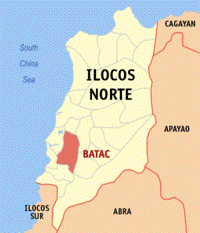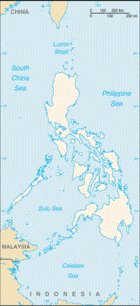"BRIEF
HISTORY OF BATAC CITY ILOCOS NORTE"
|
City
of Batac
Dak-ili ti Batak
|
|

|
|

Seal
|
|
|
Nickname: Home
of Great Leaders,
City
of My Dreams
|
|
Motto:
Aramid Pakakitaan
|
|

Province
of
Ilocos Norte Map
locating the City of
Batac
|
|

City of
Batac
Location
in the
Philippines
|
|
Coordinates:
 18°03′N
120°34′E
/ 18.05,
120.567 18°03′N
120°34′E
/ 18.05,
120.567
|
|
Country
|
Philippines
|
|
Region
|
Ilocos
Region
|
|
Province
|
Ilocos
Norte
|
|
District
|
2nd
District, Ilocos Norte
|
|
Barangays
|
43
|
|
Cityhood
|
June 23, 2007
|
|
Government
|
|
- Mayor
|
Jeffrey Jubal C. Nalupta (Elect)
|
|
- Vice
Mayor
|
Ronald Allan M. Nalupta (Elect)
|
|
Area
|
|
- Total
|
161.01 km² (62.2 sq mi)
|
|
Population (August 1, 2007)
|
|
- Total
|
50,675
|
|
Time zone
|
PST (UTC+8)
|
|
Postal
Code
|
2906
|
|
Area
code(s)
|
77
|
|
Languages
|
Ilokano, Tagalog, English
|
Batac
City
is a city in the province of Ilocos Norte, Philippines. The city is located
in the northwest corner of the large
island
of Luzon, about 11.2 km from the eastern shore of the
South China Sea
.
According to the 2007 census, it has a population of 50,675.
The motto of
Batac
City
is "Home of Great Leaders", as it is the home town of many
significant figures in the history of the
Philippines
. Among these is the former Philippine president Ferdinand Marcos. It is also
the birthplace of Gregorio Aglipay, the founder of the Philippine Independent
Church, better known as the Aglipayan Church, and Gen. Artemio Ricarte, the
"Father of the Philippine Army".
Batac
City
is well-known for being the home of the Mariano Marcos State University (MMSU),
a high-degree granting university that has several branches throughout the
province.
History
Batac is one of the oldest towns in Ilocos Norte. It was founded by the
conqiustador Juan de Salcedo in 1577, shortly after he had consolidated Spanish
rule in Vigan, Ilocos Sur.
In the early 1867, the first site of the town of
Batac
was San Josef, now Brgy. Palpalicong. Two separate communities existed at the
time. One was a Christian community headed by a chief called Captain Bazar, and
the other a non-Christian community called "Itneg", headed by Captain
Tagley, at Sitio Nagalisan, now a part of Brgy. Payao.
As
Spain
pushed further into the hinterlands, the non-Christian converted and
assimilated into the growing Christians community. The united communities grew
into the town of Batac.
In 1998,
Municipality
of
Batac
qualified to become a city. Nine years later, Republic Act 9407, the law that
converted the Municipality of Batac into a component city in the Province of
Ilocos Norte, to be known as the City of Batac, was overwhelmingly ratified by
the people in a plebiscite conducted on June 23, 2007.
Origin
of the City's Name
The word "Batac" in a local dialect translates as "pull".
More loosely, it refers to "the people's pulling their efforts
together."
Batac has an interesting colloquial origin of its name. According to a
legend, set in pre-settlement Batac, a man fell into a deep hole while he was
digging for the root crop "camangeg". He struggled to get out but
could not despite his best efforts. He cried for help but nobody was around. He
waited for hours and had given up hope of being saved. Fortunately, two men from
the neighboring town of
Paoay
happened to pass by. They heard the man shouting and traced it to where he was
trapped. Upon seeing him, they heared the man said "Bataquennac!
Bataquennac!" The two men did not understand until the man explained that
he was saying, "Pull me up! Pull me up!" They did just that. When the
two men reached their hometown, they told their story to their friends. Since
then, the town has been called "Batac," which is derived from the word
"bataquennac."
Batac is located in the mid southwestern portion of the
province
of
Ilocos Norte
. It lies approximately within altitude 17º17’ north and longitude 120º28’
east. Its boundaries include the
Municipality
of
San Nicolas
on the north;
Municipality
of
Sarrat
on the northeast;
Municipality
of
Marcos
on the east-northeast;
Municipality
of
Banna
on the east;
Municipality
of
Pinili
on the southeast;
Municipality
of
Currimao
on the southwest; and the
Municipality
of
Paoay
on the west. It is about 472 kilometers north of Metro Manila, about 18 km.
south of Laoag City, the capital of the province; 275 km. north of San Fernando
City, the regional center of Ilocos Region and 11.2 km east of the eastern shore
of
South China Sea
.
Travel time by motor vehicle at this time is very convenient because of well
paved roads and is 15 – 20 minutes to
Laoag
City
and 8 – 9 hours to Metro Manila.
Batac
City
has a total land area of 16, 101 hectares. The terrain of the city ranges from
flat to rolling and hilly and to very steep. The broad valleys are mostly
located in poblacions with a slope of 0-8%. All the rural barangays except those
in the eastern part have a slope of 0 -30%. There are various soil types that
are poorly drained due to the heavy texture of most of the subsoil. There are
two rivers that cut across the city of
Batac
, the Quiaoit River (Pagdanuman) and the
Garasgas
River
.
Batac
City
lies within the tropical rain forest climate zone (Köppenzone Af), and
experiences two distinct seasons. From the later part of May to October is the
wet season, with an annual average rainfall of 114.07 inches (PAG-ASA, 2000).
The dry season lasts from November to April.
Barangays
The City of
Batac
is politically subdivided into 43 barangays, 14 of which constitute the
poblacion.
- Aglipay (Pob.)
- Baay
- Baligat
- Bungon
- Baoa East
- Baoa West
- Barani (Pob.)
- Ben-agan (Pob.)
- Bil-loca
- Biningan
- Callaguip (Pob.)
- Camandingan
- Camguidan
- Cangrunaan (Pob.)
- Capacuan
|
- Caunayan (Pob.)
-
Valdez
(Caoayan) (Pob.)
- Colo
- Pimentel (Cubol)
- Dariwdiw
- Acosta (
Iloilo
) (Pob.)
- Ablan (Labucao) (Pob.)
- Lacub (Pob.)
- Mabaleng
- Magnuang
- Maipalig
- Nagbacalan
- Naguirangan
- Ricarte (Nalasin)
(Pob.)
|
- Palongpong
- Palpalicong (Pob.)
- Parangopong
- Payao
- Quiling Norte
- Quiling Sur
- Quiom
- Rayuray
- San Julian (Pob.)
-
San Mateo
- San Pedro
- Nalupta (Suabit) (Pob.)
- Sumader
- Tabug
|
![]()



